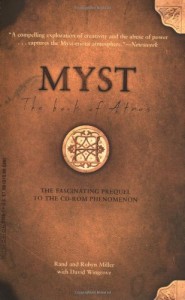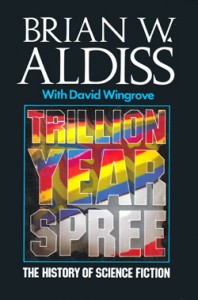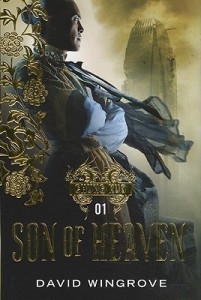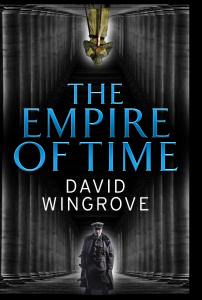 Last summer when I went to London I also attended LonCon3, the World Science Fiction Convention. While I was at the convention I had a list of people I absolutely had to meet. One of them was Simon Morden, who you will remember from last year’s “Imagine This.” Another one was David Wingrove–the co-author of the Myst Reader. Rand Miller has always been on the top of my list of people to meet, and I’d never given much thought to the other author whose name was on the title of one of my favorite series’ in the world. But when I put two and two together, I knew that this was not someone I could ignore.
Last summer when I went to London I also attended LonCon3, the World Science Fiction Convention. While I was at the convention I had a list of people I absolutely had to meet. One of them was Simon Morden, who you will remember from last year’s “Imagine This.” Another one was David Wingrove–the co-author of the Myst Reader. Rand Miller has always been on the top of my list of people to meet, and I’d never given much thought to the other author whose name was on the title of one of my favorite series’ in the world. But when I put two and two together, I knew that this was not someone I could ignore.
Actually finding David proved to be a bit difficult, despite his multiple appearances. I had a panel during his signing, and we somehow managed to miss each other at his Kaffleetch, for which no one else showed up. Locating one person in a crowd of ten thousand is a lost cause, and so my last hope was to track him down at his reading on the second-to-last day of the convention. I don’t usually attend readings, but this was my last chance at finding David, so I abandoned any other plans for that weekend and lurked in the hallway until he appeared.
After the reading (which I did greatly enjoy) David invited me to join him and some friends to chat. I was able to ask all the questions I’d had burning in my mind since coming to London, and he was more than willing to answer them. I was fascinated, and privileged, and when he gave me his card and told me to get in touch I made sure to put it somewhere safe, then promptly went home and forgot about it.
Interviews are a lot of work, and doing one as important to me as this is rather daunting. Eventually I did email David, who is a remarkably kind and generous fellow. I sent him my nosey questions (many of which were abbreviated versions of the ones I’d asked in London) and he sent me five thousands words worth of answers. Since this is way longer than most people will usually sit still to read, I’ve decided to split it into two parts. And since I’m splitting it anyway, I figured I’d re-order the questions. So Part 1 is general writing questions, and Part 2 will be specific to the Myst series.
So if you’re a fan of the Myst series, be prepared to learn more about it than you ever thought there was to know. And if you’re not a fan, become one immediately. Without further ado I present to you:
The Interview (Part 1)
First of all, tell us a little bit about yourself. What got you into writing? What were some of the projects you worked on before Myst?
 I’ve always been a story-teller: one of those people who, from an early age, tell themselves stories in their own heads. Day-dreaming, some might call it. Later on, in my late teens, I began to write some of those stories down. I was heavily – and I mean heavily – influenced by LORD OF THE RINGS. I read it time and again and wanted to do something similar. The nearest I got to actually writing my own fantasy trilogy, however, was a folder full of ideas and twenty four – yes, twenty four! – maps of this world I had envisaged (which never even got a name). I wrote the very first chapter – which was called “The Winter Smiles Of Young Men Dying” – and got bogged down.
I’ve always been a story-teller: one of those people who, from an early age, tell themselves stories in their own heads. Day-dreaming, some might call it. Later on, in my late teens, I began to write some of those stories down. I was heavily – and I mean heavily – influenced by LORD OF THE RINGS. I read it time and again and wanted to do something similar. The nearest I got to actually writing my own fantasy trilogy, however, was a folder full of ideas and twenty four – yes, twenty four! – maps of this world I had envisaged (which never even got a name). I wrote the very first chapter – which was called “The Winter Smiles Of Young Men Dying” – and got bogged down.
Or rather, I didn’t exactly get bogged down, but – and this is on my nineteenth birthday – I went on holiday to what was then Yugoslavia, and discovered (via the airport bookshop) science fiction. Asimov and Heinlein and Clarke. That holiday I read over a dozen SF novels. And suddenly I realized what had been my problem. I wasn’t a fantasy writer, I was a science fiction writer.
Cut to six months later – and we’re talking Spring 1974 now – and I’d finished my first science fiction book, a trilogy called APART. Not a very big book for a trilogy as it turned out, then again I hand wrote it in pencil without any corrections. Which is how it remained. I still have it, in a folder, untouched and unread since I’d completed it.
The point was, I knew it wasn’t very good. In fact, it was fairly awful, if I recollect. There was no point re-writing it, and certainly no point in typing it up and submitting it, but I’d learned several invaluable lessons in writing it, the most important of which was that I could actually do this. And finishing it gave me the faith that, one day, I’d write something a whole lot better.
At the same time as I was writing APART, I was also writing short stories. Science fiction stories. Looking back at them, these, like the trilogy, weren’t very good at all. But I was writing three or more every week, yes and sending them off to the magazines in the USA – to THE MAGAZINE OF FANTASY AND SCIENCE FICTION, and ANALOG, and GALAXY and IF, and many more, sending them off to the editors of those magazines with a covering letter and return postage. And, after a couple of months… the rejection letters started coming back to me from across the Ocean. Rejections. Endless rejections. More than sixty in all. Some of them with friendly, encouraging letters from the editors.
And did they put me off? Not at all. Quite the opposite, in fact, because those rejection letters – especially the ones with handwritten little notes on them from the editors – encouraged me. This was my world. I was part of this world.
One other thing happened to me in 1975, aside from the rejection letters. I entered fandom. I joined the BSFA, the British Science Fiction Association and found myself getting involved in some of their activities, like the regular bi-monthly mailings. One thing led to another, and after a while I found myself as the membership secretary. Which was important for other reasons, because in those few years I was membership secretary, I met practically all of those people who were going to remain my friends for the next thirty five years. And not just friends, but fellow SF writers.
I was also reviewing now. Three, four, five reviews an issue. Offering my opinion to the world… or at least that small part of it touched by the BSFA and its magazines. And, as ever, one thing led to another and very soon I was editing the BSFA’s critical magazine, VECTOR. A job I did for almost three years, alongside a nine to five banking job, a relationship and, of course, the writing. Working on VECTOR was crucial. It taught me lots of things. And introduced me to some of what I considered the ‘real’ writers. I went out and interviewed these people when they came over to the UK – Bob Sheckley, Fred Pohl, Frank Herbert, Brian Aldiss, Christopher Priest, and many others. People whose books I’d read and loved. Yeah… real writers.
1977 saw me go to my first science fiction convention, the Eastercon, in Coventry, much of which was a blur. Put simply, I met the Scots fans and learned how to drink. But I was bitten. In 1978, I went along again, this time to Heathrow Hotel, and met my future wife – Susan Oudot – and mother of my four daughters. Yes, it was all fated.
Sue was working for UK publishers Faber and Faber in publicity and marketing, and one of the things she was in charge of was science fiction and fantasy. Rob Holdstock was among the dozen or so SF and fantasy authors she looked after. We met and that was it. Her friends were my friends. What was more natural than that we should be friends, too? But meeting Sue was important in another way, because it was Sue who encouraged me to quit my job with National Westminster Bank and go back to College – to the University of Kent, Canterbury, where I studied English and American Literature for the next… well, seven years as it turned out. Back then students – especially mature students like I was – got given a grant to cover all expenses. That helped, but Sue for the next ten years – 1979 to 1989- effectively kept me. She worked, and I wrote, and somewhere down the line we bought a house and rebuilt it, had the first two of our daughters, and I wrote, and I wrote and…
It was in these years – following on from my work as editor of VECTOR, that I got a reputation in the science fiction field as a critic. I co-authored a book on Brian Aldiss, edited two books on science fiction – one on the literature of the field, the other on SF movies – and could genuinely, for the first time, consider myself a paid author. If not very well paid. But the high-point of those times was when the writer and critic Brian Aldiss, determined to up-date his history of science fiction, BILLION YEAR SPREE, contacted me and asked me if I’d like to co-author the new version with him. I was to cover all of the new stuff and we were to re-write and re-structure, and from all of this activity emerged TRILLION YEAR SPREE, the 1986 Hugo Award winning work.
 But even before TRILLION YEAR SPREE was conceived of, I was already deeply involved in a major venture. It was a work of fiction, not criticism. Something which, if I could get it right, might be the break-out novel that I’d dreamed of. The work was called many things from its conception on – A PERFECT ART, and A SPRING DAY ON THE EDGE OF THE WORLD are two I remember – but the title I eventually went with was CHUNG KUO. The Middle Kingdom. With over 750,000 words of the project under my belt, I took a break and re-evaluated what I was doing. With Sue’s encouragement ringing in my ears, I gave up the doctorate I was working on (on Hardy, Lawrence and Golding), and began reworking and rewriting CHUNG KUO. This was 1984/85. Ten years prior to the first of the MYST books.
But even before TRILLION YEAR SPREE was conceived of, I was already deeply involved in a major venture. It was a work of fiction, not criticism. Something which, if I could get it right, might be the break-out novel that I’d dreamed of. The work was called many things from its conception on – A PERFECT ART, and A SPRING DAY ON THE EDGE OF THE WORLD are two I remember – but the title I eventually went with was CHUNG KUO. The Middle Kingdom. With over 750,000 words of the project under my belt, I took a break and re-evaluated what I was doing. With Sue’s encouragement ringing in my ears, I gave up the doctorate I was working on (on Hardy, Lawrence and Golding), and began reworking and rewriting CHUNG KUO. This was 1984/85. Ten years prior to the first of the MYST books.
Cut three years, to the Spring of 1988, by which stage I’d totally rewritten the first of the CHUNG KUO novels, THE MIDDLE KINGDOM, which told the story of a future in which the Chinese ruled the earth. Additional to this, I’d sketched out a further four synopses of follow-up novels, charting the future history of my Chinese-ruled earth. It was this package that I presented to my agent, Hilary Rubinstein that Spring. And then waited… and waited, and then, suddenly, back it came, with a thorough edit and page after page of suggestions that might make the thing better. Which is what I did that summer, abandoning everything except my house-house-husbanding duties with my two eldest girls, Jessica and Amy, while Sue – now fiction editor at Sunday magazine – paid the bills.
The new CHUNG KUO package was sent out on the eighth day of the eight month of nineteen eighty eight, which is just about as auspicious a date as you could find when sending out a Chinese future history. And, after thirteen years of trying, I finally made a sale. My first fiction sale, that is. And not just one. In the space of the next tthree months I sold the whole series to more than a dozen different countries, including the USA, Germany, Japan, Spain, Italy, Holland, Poland and Korea.
By the time our third daughter, Georgia, arrived in 1989, the first CHUNG KUO novel was out and I was busy working on the second, THE BROKEN WHEEL. Sales were good, the reviews generally lavish in their praise. My long years of hard work seemed to have paid off. Sue took a break and started to work from home, freeing me more time to get my work done.
And so it went on for the next few years, with a book appearing roughly every eighteen months. Big, epic books that – in those pre-GAME OF THRONES days – were notable for the daring way they’d kill off major characters at the most unexpected times.
You’re working on a time travel series now, correct? Can you tell us a little bit about that?
 Time travel novels are, to my mind, the most directly science fictional of all SF works. Mine – ROADS TO MOSCOW – covers three thousand years (from 4 AD to 3000 AD) and is about the time-war that is being fought between Russia and Germany. For several hundred years their time-agents have been constantly attempting to change each other’s history, trying, in doing so, to eradicate each other. But this deadly ‘game’, played by the two great Masters of Time, Master Hecht for the Germans and Master Yastryeb for the Russians, is about to be transformed. One of the German’s leading agents – Otto Behr, our viewpoint character, born into the twenty ninth century – is about to fall in love with a young Russian woman from the thirteenth century, and everything will change.
Time travel novels are, to my mind, the most directly science fictional of all SF works. Mine – ROADS TO MOSCOW – covers three thousand years (from 4 AD to 3000 AD) and is about the time-war that is being fought between Russia and Germany. For several hundred years their time-agents have been constantly attempting to change each other’s history, trying, in doing so, to eradicate each other. But this deadly ‘game’, played by the two great Masters of Time, Master Hecht for the Germans and Master Yastryeb for the Russians, is about to be transformed. One of the German’s leading agents – Otto Behr, our viewpoint character, born into the twenty ninth century – is about to fall in love with a young Russian woman from the thirteenth century, and everything will change.
Rich in historical detail, ROADS TO MOSCOW is comprised of three novels, THE EMPIRE OF TIME, THE OCEAN OF TIME and THE MASTER OF TIME. The first two have already been published, by DelRey in the UK, and by the end of June, the final volume will be finished and delivered to my publishers. All in all, in its final form it’ll be half a million words of what I’d claim to be the most readable time travel work you could wish for.
So… when that’s done, I then plan to finish the CHUNG KUO series, rewriting the original ending, THE MARRIAGE OF THE LIVING DARK, published originally back in 1997, after the third of the MYST novels. The new ‘ending’ will, in fact, be five fairly substantial books, giving the CHUNG KUO sequence a new and much better resolution.
And at the same time that I’m working on that, I’ll be putting together a structure for a completely new, stand alone novel… my first overtly Fantasy novel … which has the working title of BURYING THE SMITH. I’ve already written the opening, and, in these post-Tolkein, post-George R R Martin days, I aim to come up with something that will have the same flavour, the same impact as those two.
Do you have a favorite book that you’ve written?
That’s difficult to say, but maybe the first of the CHUNG KUO prequels that I wrote for the new version of the sequence, SON OF HEAVEN, which I enjoyed writing because for once it showed how – feasibly – we might come to a situation in the coming days in which Armageddon looms and civilization falls apart. The bridging of a feasible near future with a Chinese-run future world was enjoyable to write, and I know my fans enjoyed it. Over here, on Amazon UK’s E-book listing, it even kept George Martin’s GAME OF THRONES off the number one spot for a whole month after publication, so I must have been doing something right!
Who are some favorite authors that you enjoy to read?
I’ve quite a list. Brian Aldiss, especially for his HELLICONIA trilogy. Ursula LeGuin, for THE LEFT HAND OF DARKNESS and THE DISPOSSESSED. Frank Herbert, for DUNE. George R R Martin, Joe Abercombie, Iain Banks. And who else? Tolkein, of course. Oh yes, and Philip K Dick, who was a one man genre. Dick, more than anyone, is, to my mind, the greatest science fiction writer of all. I mean… UBIK, MARTIAN TIME SLIP, FLOW MY TEARS, THE POLICEMAN SAID, THE THREE STIGMATA OF PALMER ELDRITCH, THE MAN IN THE HIGH CASTLE, and DO ANDROIDS DREAM OF ELECTRIC SHEEP – filmed as BLADE RUNNER. All of them flawed but still works of genius. Oh, and Dick makes an appearance in THE OCEAN OF TIME, the second book in the trilogy. There’s a whole section in it where Otto goes to see him, back in California in the fifties… That was such fun writing that.
And finally, many of our readers are aspiring authors and creators themselves. Do you have any advice to give them?
Yes. My advice is never give up. And keep writing. Every day, if possible. Because the only way to learn how to write is to actually sit down in front of your laptop and write. Never ever get disheartened. Failure – and rejections – are simply part of the process of becoming a writer, so keep at it. Develop a thick skin and, as the saying goes, get back up in the saddle. No one – well, Robert Heinlein maybe – ever gets everything published first time round. So dust yourself off and get back up there.
Pingback: Interview With David Wingrove (Part 2) - Vaguely Circular
Pingback: Interview with David WIngrove co-author of the Myst Books | Myst Movie Fans